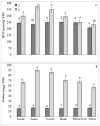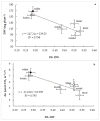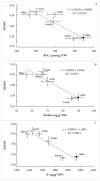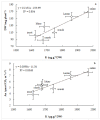Functional Dissection of the Physiological Traits Promoting Durum Wheat (Triticum durum Desf.) Tolerance to Drought Stress
- PMID: 37050046
- PMCID: PMC10096688
- DOI: 10.3390/plants12071420
Functional Dissection of the Physiological Traits Promoting Durum Wheat (Triticum durum Desf.) Tolerance to Drought Stress
Abstract
In Tunisia's arid and semi-arid lands, drought stress remains the most critical factor limiting agricultural production due to low and irregular precipitation. The situation is even more difficult because of the scarcity of underground water for irrigation and the climate change that has intensified and expanded the aridity. One of the most efficient and sustainable approaches to mitigating drought stress is exploring genotypic variability to screen tolerant genotypes and identify useful tolerance traits. To this end, six Tunisian wheat genotypes (Triticum durum Desf.) were cultivated in the field, under a greenhouse and natural light, to be studied for their differential tolerance to drought stress. Many morpho-physiological and biochemical traits were analyzed, and interrelationships were established. Depending on the genotypes, drought stress significantly decreased plant growth, chlorophyll biosynthesis, and photosynthesis; stimulated osmolyte accumulation and disturbed water relations. The most tolerant genotypes (salim and karim) accumulated more potassium (K) and proline in their shoots, allowing them to maintain better tissue hydration and physiological functioning. The osmotic adjustment (OA), in which potassium and proline play a key role, determines wheat tolerance to drought stress. The calculated drought index (DI), drought susceptible index (DSI), drought tolerance index (DTI), K use efficiency (KUE), and water use efficiency (WUE) discriminated the studied genotypes and confirmed the relative tolerance of salim and karim.
Keywords: drought susceptible index; drought tolerance index; durum wheat; photosynthesis; proline; relative osmolyte content.
Conflict of interest statement
The authors declare no conflict of interest.
Figures









Similar articles
-
Genotypic differences in response of durum wheat (Triticum durum Desf.) to lime-induced iron chlorosis.Plant Direct. 2022 Jan 9;6(1):e377. doi: 10.1002/pld3.377. eCollection 2022 Jan. Plant Direct. 2022. PMID: 35028496 Free PMC article.
-
Differential response of NADP-dehydrogenases and carbon metabolism in leaves and roots of two durum wheat (Triticum durum Desf.) cultivars (Karim and Azizi) with different sensitivities to salt stress.J Plant Physiol. 2015 May 1;179:56-63. doi: 10.1016/j.jplph.2015.02.009. Epub 2015 Mar 18. J Plant Physiol. 2015. PMID: 25835711
-
Effect of saline irrigation on plant water traits, photosynthesis and ionic balance in durum wheat genotypes.Saudi J Biol Sci. 2021 Apr;28(4):2510-2517. doi: 10.1016/j.sjbs.2021.01.052. Epub 2021 Feb 2. Saudi J Biol Sci. 2021. PMID: 33911962 Free PMC article.
-
Nutrient management: as a panacea to improve the caryopsis quality and yield potential of durum wheat (Triticum turgidum L.) under the changing climatic conditions.Front Plant Sci. 2023 Aug 28;14:1232675. doi: 10.3389/fpls.2023.1232675. eCollection 2023. Front Plant Sci. 2023. PMID: 37701803 Free PMC article. Review.
-
Drought tolerance in modern and wild wheat.ScientificWorldJournal. 2013 May 15;2013:548246. doi: 10.1155/2013/548246. Print 2013. ScientificWorldJournal. 2013. PMID: 23766697 Free PMC article. Review.
Cited by
-
Potential of Seed Halopriming in the Mitigation of Salinity Stress during Germination and Seedling Establishment in Durum Wheat (Triticum durum Desf.).Plants (Basel). 2023 Dec 25;13(1):66. doi: 10.3390/plants13010066. Plants (Basel). 2023. PMID: 38202374 Free PMC article.
-
Exploring the Drought Tolerant Quantitative Trait Loci in Spring Wheat.Plants (Basel). 2024 Mar 21;13(6):898. doi: 10.3390/plants13060898. Plants (Basel). 2024. PMID: 38592925 Free PMC article.
-
Morpho-physiological traits of soybean plants in symbiosis with Gigaspora sp. and submitted to water restriction.Sci Rep. 2025 Feb 28;15(1):7133. doi: 10.1038/s41598-025-92024-6. Sci Rep. 2025. PMID: 40021818 Free PMC article.
References
-
- Field R.D., Kim D., LeGrande A.N., Worden J., Kelley M., Schmidt G.A. Evaluating climate model performance in the tropics with retrievals of water isotopic composition from Aura TES. Geophys. Res. Lett. 2014;41:6030–6036. doi: 10.1002/2014GL060572. - DOI
-
- Daryanto S., Wang L., Jacinthe P.A. Global synthesis of drought effects on cereal, legume, tuber and root crops production. Agric. Water Manag. 2017;179:18–33. doi: 10.1016/j.agwat.2016.04.022. - DOI
-
- Mustapha H., Ilyas N., Akhtar N., Raja N.I., Zainab T., Shah T., Ahmad A., Ahmad P. Biosynthesis and characterization of titanium dioxide nanoparticles and its effects along with calcium phosphate on physicochemical attributes of wheat under drought stress. Ecotoxicol. Environ. Saf. 2021;223:112519. doi: 10.1016/j.ecoenv.2021.112519. - DOI - PubMed
LinkOut - more resources
Full Text Sources

